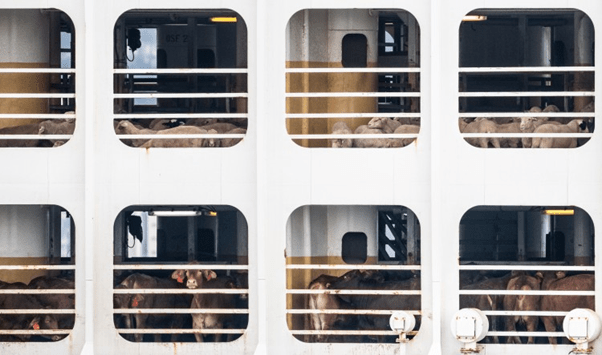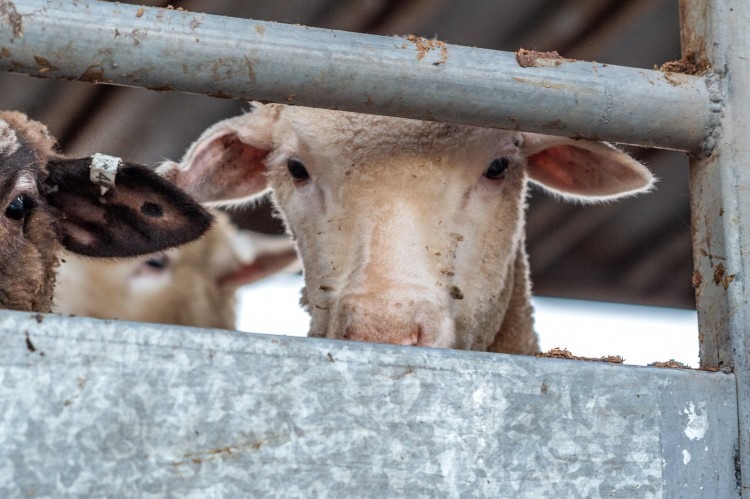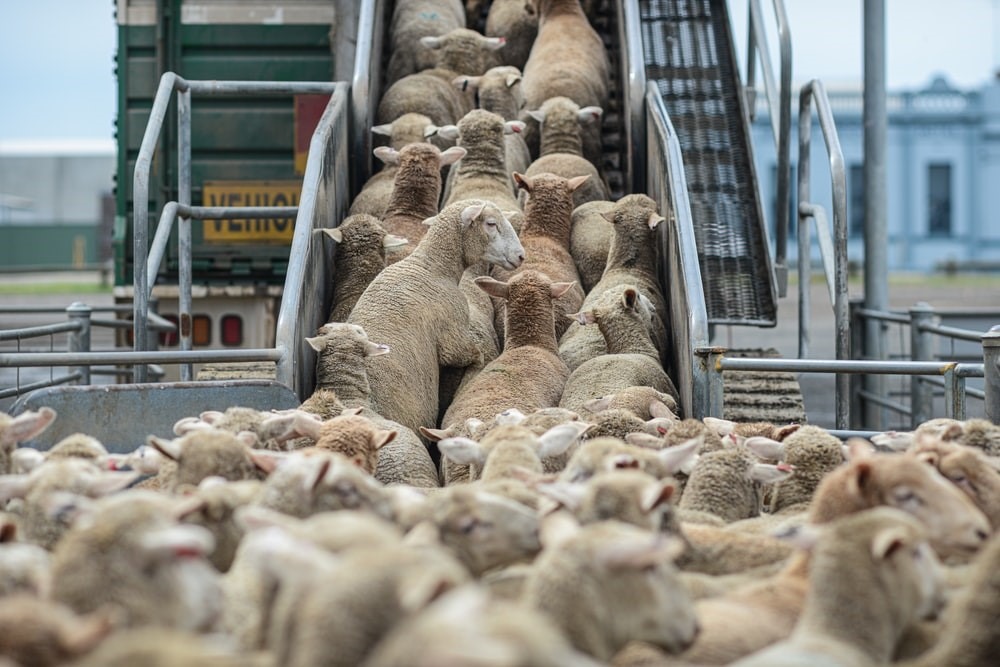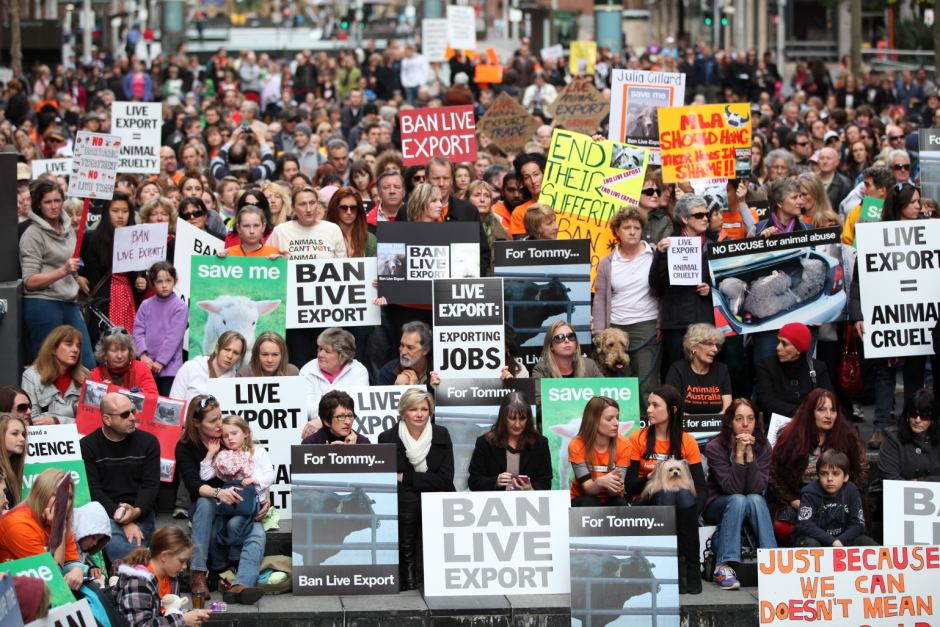
What is live export?
Live export refers to the transport of animals to other countries for various purposes, such as slaughter or breeding. Although a wide variety of animals are traded around the world (including horses, cats, dogs and exotic animals), most media and political attention has focused on the trade of live farmed animals. Given the sheer distances required to travel overseas and ongoing evidence of animal cruelty, Australia’s live export industry has been under scrutiny for decades.
Australian live export industry
Australia has one of the largest live export industries in the world, contributing over $800 million to the Australian economy each year, and constituting 0.5% of the Australian export market.1 A range of animals (alpacas, buffalo, camels, cattle, deer, sheep and goats) are exported live to over 60 countries around the world, particularly to countries in the Middle East. Some of these animals are used for breeding but most are slaughtered for human consumption.
There are significant animal welfare risks throughout the live export process which are difficult and in many cases impossible to address through regulation. For this reason, Australians have mobilised in large numbers to protest the ongoing trade and advocate for a ban on live export.

What are the welfare issues?
There are a range of significant animal welfare issues associated with live export, many of which are inherent to the process and cannot be ‘regulated out’.
Stress and food & water deprivation
Before boarding the ships, animals destined for live export often endure significant stresses during transport by road or rail to ports. In Australia, truck journeys can last up to two days.2 Stresses include high temperatures, food and water deprivation and high stocking densities, which can lead to dehydration, bruising and salmonellosis in sheep and respiratory disease in cattle.3 Once on board the ships, the welfare and mortality risks increase.
Long trips and heat stress
Animals can be confined for up to five weeks on sea vessels, which equates to 840 consecutive hours spent on board in close proximity to thousands of other animals. High temperatures and poor ventilation can contribute to fatal heat stroke, particularly in those breeds whose physiology is ill-suited to hot climates.4 Animals suffering from heat stress experience a range of distressing symptoms, including difficulty breathing, panting and staggering. According to RSPCA Australia, mortality almost doubles when sheep are transported to the Middle East during the hot Middle Eastern summer months. This was the case on board the Awassi Express voyage, where 2400 sheep died from heat stress.
High stocking density
Ships have high stocking densities, carrying up to 70,000 animals on board in close confinement. At this density, it is not possible to meet all the welfare needs of the animals. In fact, evidence suggests that the number of animals loaded onto vessels may need to be halved in order to meet these needs.
Failure to eat on board
On board ships, sheep are transferred from a pasture-based diet to concentrated pellets – a change which some animals reject. Failure to eat can lead to salmonellosis and even death, with around half of sheep mortalities occurring this way.5 Faecal contamination of food and water, as well as difficulty in accessing feed due to feed trough placement and stocking density can also create significant barriers to achieving sufficient nutrition.
Sanitation issues
Animal waste generates ammonia gas which, in high concentrations on board vessels, can irritate the eyes, nasal cavities and respiratory tracts of animals, causing crying, coughing and nasal discharge. Sheep have shown a clear aversion to ammonia and tests have shown that it adversely affects the welfare of steers.6 More than 100,000 litres of urine and faeces can be produced every day on an average live export ship, which in addition to the issues caused by ammonia build-up, can also lead to slipping and injury.

Deaths during transit
Each year, thousands of Australian animals die during live export sea voyages.7 Deaths are caused by a range of factors, including heat stress and diseases, disorders and injuries developed on board. This is considered to be a routine and unavoidable aspect of the trade, and as long as exporters keep their voyage mortality rates under a certain percentage rate, the Government will not investigate. The Government only investigates when the acceptable mortality rate is exceeded, which in the case of sheep exported by sea is a rate over 1% of the total number of animals on board. RSPCA Australia reports that since 2006, there have been at least 70 occasions where the reportable mortality levels were exceeded. Even if mortality rates were maintained within the acceptable range, the use of mortality as a welfare indicator is highly questionable.
Animal welfare issues in destination countries
On arrival, animals are subject to various welfare risks. In overseas destinations with different climates, animals must adjust to new and sometimes extreme temperatures, especially in the case of sheep transported from Australia to the Middle East. They generally endure long waiting periods before disembarking ships and being loaded onto trucks, where rough handling can cause distress and injury. During truck journeys to feedlots and/or slaughterhouses, they are usually denied access to food or water which can lead to dehydration and exhaustion. Once at the slaughterhouse, they may be subject to a range of different slaughter methods, including unskilled and sometimes illegal methods which cause pain and suffering.

How do we know what is happening?
It is difficult to know exactly what happens on live export voyages, as there is no CCTV footage and very few people have access to the ships. However, increasingly we are learning more about the concerning experiences of animals on board thanks to the efforts of whistleblowers, investigations conducted by animal advocates, and official reports from independent observers. There have also been a series of official inquiries and investigations into the trade by the Government.
Whistleblowers
A number of former employees (‘whistleblowers’) involved with Australia’s live export industry have brought to light incidents of cruelty and suffering on board vessels. The evidence provided by whistleblowers has demonstrated significant regulatory failure and non-compliance, often leading to regulatory reforms and in some cases temporary bans on the trade.
Case Study – Veterinarian Dr Lynn Simpson
In 2016, former live export veterinarian Dr Lynn Simpson spoke out about the extreme animal suffering she witnessed first-hand aboard 57 live export voyages. Her accounts demonstrate ongoing and systemic non-compliance with regulations by the industry. Dr Simpson was removed from her position after submitting a report detailing the conditions she witnessed on live export ships. Read more on the Voiceless Blog.
Case Study – Trainee Navigator Faisal Ullah
In 2018, trainee navigator Faisal Ullah filmed the conditions on board the Awassi Express live export ship, and released the footage to 60 Minutes and Animals Australia. The footage depicted serious breaches of animal welfare regulations, including overcrowded sheep suffering from severe heat stress. Mr Ullah was distressed by the footage, describing the conditions on board as ‘just terrible’.8 He said that he couldn’t tolerate the ‘severity of the suffering’ and reportedly witnessed young lambs being crushed by other animals.9
Independent Observers
Following the Awassi Express incident in 2018, the Australian Government introduced independent observers on board vessels to monitor and publicly report on how animal health and welfare is managed during sea voyages. Not all voyages are required to have an independent observer (IO) on board, and those that do are only required to have one IO regardless of the number of animals being transported. IO reports are made public by the Government, whose involvement in the process has been criticised as leading to the provision of ‘sanitised’ summaries. In 2020, the deployment of independent observers was temporarily paused due to the COVID-19 global pandemic.
Overseas investigations
Once animals arrive at their intended destinations they are no longer protected under Australian law and it is very difficult for the Australian Government to monitor their welfare. Numerous exposés, investigations and reports into the Australian live export trade by animal advocates and animal protection organisations have produced evidence of severe and systemic animal cruelty in destination countries. Overseas investigations by NGOs are responsible for prompting many of the key regulatory reforms that have been implemented over recent years.
Case study – Indonesia
In 2011, ABC’s Four Corners program aired revelations that Australian cattle were subject to significant cruelty in Indonesian abattoirs. The majority of live cattle exported from Australia have traditionally been sent to Indonesia, with more than 6.4 million individuals shipped there over the 20 years prior to the exposé.
The program aired footage which filmed 50 slaughters in 10 different locations. Analysis of the recordings by the Chief Scientist of RSPCA Australia, Dr Bidda Jones, showed that painful handling techniques (such as kicking, hitting, eye gouging, tail-breaking and tendon-slashing) were used in 90% of locations, causing severe pain and injury.10 It took an average of 11 cuts to the throat and a maximum of 33 to slaughter fully conscious animals, and cattle were restrained for slaughter using ‘Mark 1’ boxes, which ‘inherently result in extreme distress and, in some cases, physical injury’.11 Although these devices contravene OIE (World Organisation for Animal Health) standards, their installation was subsidised by $1.2 million in Australian taxpayer funds.12
The breadth of the investigation strongly suggested that these cruelties were ‘reflective of the treatment of Australian cattle in general in that country’13 and within days of the program airing, hundreds of thousands of Australians called for a ban on live export by signing petitions, attending public rallies and inundating politicians with emails, letters and phone calls.14 The Federal Government suspended the trade to Indonesia in June 2011 before resuming it one month later. In 2020, a Federal Court judgment subsequently declared that the decision to impose a ban was invalid.15
Government information, parliamentary reports and independent inquiries
Government and parliamentary inquiries into the operation and regulation of the trade have been conducted since the 1980s. In fact, in 1985 a Senate Select Committee report into the trade was released, concluding that ‘if a decision were to be made on the future of the trade purely on animal welfare grounds, there is enough evidence to stop the trade’.16 There have been numerous inquiries conducted over the past decade, generally in response to exposés revealed by the media as a result of investigations by NGOs. For example, in the wake of the Awassi Express incident, the Government commissioned three reviews: (1) a review into the regulatory capability and culture of the department in charge of regulation; (2) a review of the Australian Standards for the Export of Livestock, and; (3) a review into the standards for sheep exported during the northern hemisphere summer.
Most reforms made to the live export regime have followed the release of inquiry reports, such as the McCarthy Review which led to a decrease in the reportable mortality level for sheep (from 2 to 1 per cent) and the Moss Review which led to the establishment of the Inspector-General of Live Animal Exports.
Inspector-General of Live Animal Exports
The Inspector-General of Live Animal Exports (IGLAE) was established in 2019 to review the performance of the functions and exercise of powers by the federal government department in charge of regulating live export (the Department of Agriculture, Water and the Environment). The IGLAE’s first report made numerous recommendations, including calling for increased departmental transparency, more effective use of sanctions, installation of CCTV on ships, and greater scrutiny of ship veterinarians.
Read about why Australia needs an Independent Office of Animal Welfare here.
How is live export regulated in Australia?
Live export is mainly regulated by the Australian Government at the national level, through a complex system of laws and regulations. Summarised below are some of the key elements of the regulatory regime.
Regulation of animal welfare on board ships
Exporters are responsible for the welfare of all animals on board their ships, and must comply with the Australian Standards for the Export of Livestock (ASEL). One ASEL requirement is to have accredited stockpersons on board, who care for the health, welfare, and physical needs of the animals during loading, sailing and disembarking. On voyages of 10 days or more, the government also requires that one registered veterinarian must be present.17 This means that one vet may be in charge of the health and wellbeing of tens of thousands of animals. Some voyages also have an independent observer on board (see above).
Regulation of animal welfare throughout the supply chain
In an attempt to regulate the welfare of Australian animals in destination markets, the Australian Government implemented the Exporter Supply Chain Assurance System (ESCAS) in 2011. ESCAS aims to improve control and traceability of Australian animals throughout the live export supply chain, and requires that transport, handling and slaughter in destination countries complies with OIE welfare standards.
Since 2012, there have been 184 reports of ESCAS breaches. Breaches in export destinations are difficult to detect, with many identified and reported by animal protection organisations. Although the government can punish exporters who breach ESCAS, historically they have been hesitant to apply significant penalties. RSPCA Australia argues that sanctions applied to date have been ‘manifestly inadequate and have failed to act as a sufficient deterrent to neglecting animal welfare responsibilities’.

Did you know? ESCAS does not apply to animals exported for breeding purposes, such as dairy cows. Read more about the live export of dairy cows in Voiceless’s report on the Australian dairy industry – The Life of the Dairy Cow.
Case study – Pakistan
In August 2012, an Australian ship carrying approximately 22,000 sheep was blocked from unloading in Kuwait and Bahrain after local authorities claimed that the animals had scabby mouth disease.18 The sheep had already been at sea for 33 days and were left on board for almost two weeks longer, suffering in temperatures of up to 38 degrees.19 Eventually the sheep were unloaded in Pakistan, where it was later reported that around 9,000 of the sheep had been killed on suspicion that they were diseased.20 A recording of their slaughter showed brutal treatment: ‘Like a giant mass of wool, bloodied and filthy, they lay in trenches – slit open, stabbed or clubbed to death, while many still wriggled with some life left in them, soon to be buried alive.’21 The Australian Government tried to intervene to stop the cull but, despite its efforts, all of the remaining sheep were eventually killed.
Is live export adequately regulated?
There are many issues with the live export regulatory regime which undermine its operation and effectiveness.22
1. Jurisdictional barriers
Australian laws cannot be enforced on individuals in foreign jurisdictions, creating an animal protection gap. Although ESCAS has sought to address this gap to some extent, the history of non-compliance with ESCAS suggests that the system is not capable of adequately protecting Australian animals overseas. Furthermore, it is impossible to know the full extent of animal welfare violations in destination countries where the Australian Government has no authority.
2. Inherent cruelties
It is not possible for the regulatory regime to address many key animal welfare concerns, as they are inherent to the process of exporting live animals. Even with best practice standards and regulations in place, animal welfare will always be jeopardised during export. Enduring stress, injuries and diseases on board is unavoidable, especially at the stocking densities required to make voyages profitable.
3. Mortality as a welfare indicator
Mortality rates are a poor indicator of welfare and fail to take into account the inherent value of animals as sentient individuals. Measuring animal welfare by how many animals regularly die on an average voyage creates a very low welfare threshold and implicitly accepts a significant degree of suffering as an acceptable status quo.
4. Inadequate compliance and enforcement
There is continuing evidence of inadequate monitoring, repeated breaches and non-compliance with the regulatory framework. It is clear that government compliance monitoring is insufficient, as many of the most significant breaches have been exposed by NGOs. Even when non-compliance is identified, inadequate penalties are generally imposed, reducing the deterrence effect and ultimately failing exported animals.

Read more about the legal issues associated with live export in the Voiceless Animal Law Toolkit.
Should Australia ban live export?
There are many compelling reasons to ban live export in Australia.
- Animals are sentient, feeling beings who deserve to be treated with compassion and respect.
- The Government cannot adequately supervise and guarantee the welfare of animals on ships or in destination countries, and Australia should not support an industry that is incapable of adequate regulation.
- It is not possible to transport large volumes of animals across the world at such high stocking densities without causing animal welfare issues.
- Deaths on board are an inevitable by-product of densely packing live animals onto ships for long periods of time. If stocking densities were increased, profits would decrease, meaning that there is a direct conflict of interest between pursuing profitability and protecting animal welfare.
What is the future of the industry?
A 2019 public survey of close to 120,000 Australian citizens, revealed that 58%, or almost two thirds, of the participants ‘somewhat or strongly agreed’ with abolishing the Australian live export trade.
Given this public sentiment, unsurprisingly Australia has already made moves towards limiting the trade, with the Government introducing a raft of reforms aimed at increasing industry accountability and compliance. In 2020, the Government implemented a ban on live sheep exports to the Middle East during the hottest summer months (1 June – 14 September). Although this is a positive animal welfare development to some extent, the reform was criticised on the grounds that it still allows the trade to continue throughout other ‘high risk’ periods. The partial ban has also been undermined by the fact that soon after implementing the reform the Government granted an exemption allowing a voyage to proceed, which resulted in all sheep on board suffering from heat stress.
A number of politicians have put forward proposed legislation to ban or phase out live export, however the Government remains supportive of the trade, viewing it as a ‘valuable Australian industry’ creating jobs in rural and regional Australia. Meanwhile, the ‘Ban Live Export’ campaign continues to grow, leaving the future of the industry uncertain.

What is Voiceless doing to address live export?
Voiceless supports an immediate end to the commercial export of live sentient animals. As argued by Voiceless Patron and former High Court Justice, the Honourable Michael Kirby AC CMG, ‘The paramount consideration must now be the ethical one. The live export trade as currently carried out is indefensible. It must stop.’23
Through our Animal Protection Education (APE) program we are raising awareness of the animal welfare issues in live export amongst the next generation of changemakers, recently releasing a suite of educational resources on the topic for use in Australian high schools. Access them here.
We are also raising awareness of the need for law and policy reform in this area through our Animal Law Education (ALE) program.
LEARN MORE
- Read articles on the Voiceless Blog exploring the issue of live export.
- Access our latest Animal Protection Education high school educational resources investigating the animal welfare issues associated with the live export trade.
- Watch our video, Live Animal Export Explained.
- Read our fact sheet, Across Land and Sea: Live Export Explained.
- Listen to our Voiceless Animal Law Talk podcast exploring animal law and policy reform in Australia, including a discussion of reforms in the live export space with leading Australian animal lawyers.
- Australian Government, ‘Composition of Trade Australia 2018-19’ (2020) 52 <https://www.dfat.gov.au/sites/default/files/cot-2018-19.pdf?>.
- ‘Meat Exports vs Live Exports’, RSPCA Australia (Infographic) <https://www.rspca.org.au/sites/default/files/website/Campaigns/Live-export/RSPCA-live_export_vs_meat_export_infographics.pdf>.
- Clive J. Phillips, ‘The Welfare of Livestock During Sea Transport’ in Michael C. Appleby et al (eds), Long Distance Transport and Welfare of Farm Animals (CABI, 2008) 137, 140.
- R Norris et al., ‘Cattle Deaths During Sea Transport From Australia’ (2003) 81 Australian Veterinary Journal 156-161.
- Meat & Livestock Australia, ‘Inanition in sheep – a literature review’ (last updated 19 Sep 2018) <www.mla.com.au/research-and-development/search-rd-reports/final-report-details/Live-Export/Inanition-in-sheep-a-literature-review/313>.
- Drummond, J. et al., ‘Exposure of Lambs to Atmospheric Ammonia’ (1976) 42(5) Journal of Animal Science 1343; Clive J. Phillips, Matthew K. Pines and Tracy Muller, ‘The Physiological And Behavioral Responses Of Steers To Gaseous Ammonia In Simulated Long-Distance Transport By Ship’ (2010) 88 Journal of Animal Science 3579; Clive J. Phillips et al, ‘The Avoidance Of Ammonia By Sheep’ (2012) 7 Journal of Veterinary Behaviour 48.
- Australian Department of Agriculture, Water and the Environment, ‘Investigations into Mortalities’ (last reviewed 20 Nov 2020) <https://www.agriculture.gov.au/export/controlled-goods/live-animals/livestock/regulatory-framework/compliance-investigations/investigations-mortalities#2018>.
- Neelima Choahan, ‘Channel Nine’s 60 Minutes Show Distressed, Dying Animals on Board’, Sydney Morning Herald (online, 8 April 2018) <https://www.smh.com.au/national/channel-nine-s-60-minutes-show-distressed-dying-animals-on-board-20180408-p4z8g9.html>.
- Ibid.
- Bidda Jones, ‘The Slaughter of Australian Cattle in Indonesia: An Observational Study’ (Report, RSPCA Australia, 2011) 4-5.
- Ibid.
- Second Reading Speech, Live Animal Export (Slaughter) Prohibition Bill 2011, Senator Rachel Siewert 15 June 2011 at 2880.
- Jones (n 10).
- See, for example: ‘Campaigns Archive: Ban Live Export’ (2012) GetUp! Action for Australia <www.getup.org.au/campaigns/campaigns-archive>; ‘Protest Against Live Export Trade’, Herald Sun (Melbourne), 18 June 2011 <www.heraldsun.com.au/news/meat-industry-like-slave-traders/news-story/05da31770fba627833a30c7551eed453>; Peter Martin, ‘Complaints Over Live Cattle Exports Handled By Centrelink Staff, Documents Reveal’, The Sydney Morning Herald (Sydney), 12 August 2011 <www.smh.com.au/environment/conservation/complaints-over-live-cattle-exports-handled-by-centrelink-staff-documents-reveal-20110811-1iotp.html>.
- Brett Cattle Company Pty Ltd v Minister for Agriculture [2020] FCA 732.
- RSPCA Australia, ‘A Timeline of Tragedy’ <https://www.rspca.org.au/live-exports-timeline-tragedy>.
- ‘What Are the Standards of Animal Welfare Onboard Live Export Ships?’, RSPCA Australia (Web Page, 29 May 2020) <https://kb.rspca.org.au/knowledge-base/what-are-the-standards-of-animal-welfare-onboard-live-export-ships/>.
- ‘Stranded Live Export Sheep Unloaded at Kuwait’ (4 September 2012) ABC News <www.abc.net.au/news/2012-09-04/stranded-live-export-sheep-unloaded-at-kuwait/4241916>.
- Sarah Ferguson and Deb Masters, ‘Another Bloody Business’ (7 November 2012), ABC Four Corners <www.abc.net.au/4corners/stories/2012/11/02/3623727.htm>.
- Ibid.
- Richard Willingham citing report by M Waqar Bhatti, ‘Australian Sheep Clubbed, Stabbed, Buried Alive: Pakistan Report’ (27 September 2012) The Sydney Morning Herald <https://www.smh.com.au/environment/conservation/australian-sheep-clubbed-stabbed-buried-alive–pakistan-report-20120927-26n91.html>.
- The information in this section has been extracted and edited from the Voiceless Animal Law Toolkit (2nd edition, 2015) 30-33 <https://voiceless.org.au/voiceless-animal-law-toolkit-second-edition/>.
- Michael Kirby, ‘Stand Up and Speak Up for Animals That Cannot’ (13 August 2011) The Sydney Morning Herald <www.smh.com.au/environment/conservation/stand-up-and-speak-up-for-animals-that-cannot-20110813-1irp5.html>.
